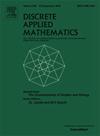图的路径序列
IF 1
3区 数学
Q3 MATHEMATICS, APPLIED
引用次数: 0
摘要
设P(G)=(P0(G),P1(G),…,P (G))为图G的路径序列,其中Pi(G)为图G中长度为i的路径数,ρ为图G中最长路径的长度。本文首先给出了一些图的路径序列,并证明了星形树中长度为h的路径数完全由其长度不大于h−2的分支决定。然后我们从另一个角度考虑路径序列是否表征了一个图,并发现在某些图族中的任意两个图当且仅当它们具有相同的路径序列是同构的。本文章由计算机程序翻译,如有差异,请以英文原文为准。
The path sequence of a graph
Let be the path sequence of a graph , where is the number of paths with length and is the length of a longest path in . In this paper, we first give the path sequences of some graphs and show that the number of paths with length in a starlike tree is completely determined by its branches of length not more than . And then we consider whether the path sequence characterizes a graph from a different point of view and find that any two graphs in some graph families are isomorphic if and only if they have the same path sequence.
求助全文
通过发布文献求助,成功后即可免费获取论文全文。
去求助
来源期刊

Discrete Applied Mathematics
数学-应用数学
CiteScore
2.30
自引率
9.10%
发文量
422
审稿时长
4.5 months
期刊介绍:
The aim of Discrete Applied Mathematics is to bring together research papers in different areas of algorithmic and applicable discrete mathematics as well as applications of combinatorial mathematics to informatics and various areas of science and technology. Contributions presented to the journal can be research papers, short notes, surveys, and possibly research problems. The "Communications" section will be devoted to the fastest possible publication of recent research results that are checked and recommended for publication by a member of the Editorial Board. The journal will also publish a limited number of book announcements as well as proceedings of conferences. These proceedings will be fully refereed and adhere to the normal standards of the journal.
Potential authors are advised to view the journal and the open calls-for-papers of special issues before submitting their manuscripts. Only high-quality, original work that is within the scope of the journal or the targeted special issue will be considered.
 求助内容:
求助内容: 应助结果提醒方式:
应助结果提醒方式:


